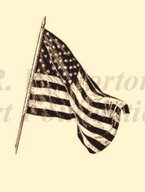
|

|
|
|
|
As a youngster, he was known as "Buck" to family and friends. Later a friend nicknamed him "Hank," and it stuck. Hank was born in Shreveport at Highland Hospital, along with a twin sister, Alice, to Charles Randolph Stoer and Virginia Brown Stoer, also known as "Jenny." Of the Depression, he recalls his mother telling him his father's salary had been cut in half, but the family always managed to eat. "We were pretty poor at the time, but I never realized I was poor," he says. His mother also fed elderly neighbors as well as hobos. He also recalls outbreaks of polio, along with chicken pox, measles, and diphtheria. "My sister and I, brother, were quarantined several times for the diseases back then," he recalls. In high school, Hank worked at the A&P grocery store in summer and all year on Saturdays, usually from 6:30 a.m. to 7 or 8 p.m. Although he ran track for Byrd High School, he had to miss competitions held on Saturday because of his work. Hank graduated in 1937 from Byrd High School, wanting to attend college. He liked art, and had been a student at the Southwestern Art Institute on Jordan Street, but his father did not want to pay for art school. Hank combined his interest in biology with his activities at Dunlap Presbyterian Church, and considered becoming a medical missionary. Enrolling at LSU as a pre-medical major, he was elected as president to Beta Tau Mu, the pre-med society, and graduated in 1941. The army sent him to medical school. He was inducted at Fort Livingston as a private in the Army Medical Corps, then was returned to New Orleans and the LSU School of Medicine. The army took care of his tuition and books, and paid Hank $50 per month. He graduated in December of 1943. "Due to the war the courses were three years instead of four," he says. "When I was in medical school there was no vacation times. We spent the whole time in school." Upon finishing medical school he joined the Reserve Officers Corps, then served an internship and began an 18-month residency in pathology at Charity Hospital in New Orleans. "I lived out of Merck manuals (The Merck Manual of Diagnosis and Therapy) trying to treat patients," he says. Hank recalls the difficulty in treating diseases at that time. "We didn't have antibiotics to start with. We had sulfa drugs." He used penicillin for the first time on a pneumonia patient he thought was terminally ill. The patient survived. "A miracle," he calls the drug. He also ran the venereal clinic, where he saw "more venereal disease than the average doctor sees in several life times." In 1944, he married Jessie Pearl Holman, a nurse, whom he had met with they were both LSU students. They would have three children. The army sent him to his first duty station at Brooks General Hospital in San Antonio where he learned basic army skills, such as marching and digging a latrine. Ordered to the 8th Army Area Laboratory at Fort Lewis, Washington, he treated illnesses of returning veterans, many, it was believed, infected with syphilis. Because of their illness they were given "blue discharges" or "blue tickets," which were neither honorable nor dishonorable discharges. They were given to men (disproportionately to African Americans) thought to be homosexual. Hank, however, found most were being misdiagnosed. "I'm sure a lot of them have a history now of being diagnosed with syphilis in the service and they never had it," he says of World War II veterans. As a pathologist, he also did autopsies. After his service, Hank finished his residency, taught medical school, and then moved to Shreveport in 1954 as director of the department of pathology at Schumpert Hospital. He retired in 1985. |


